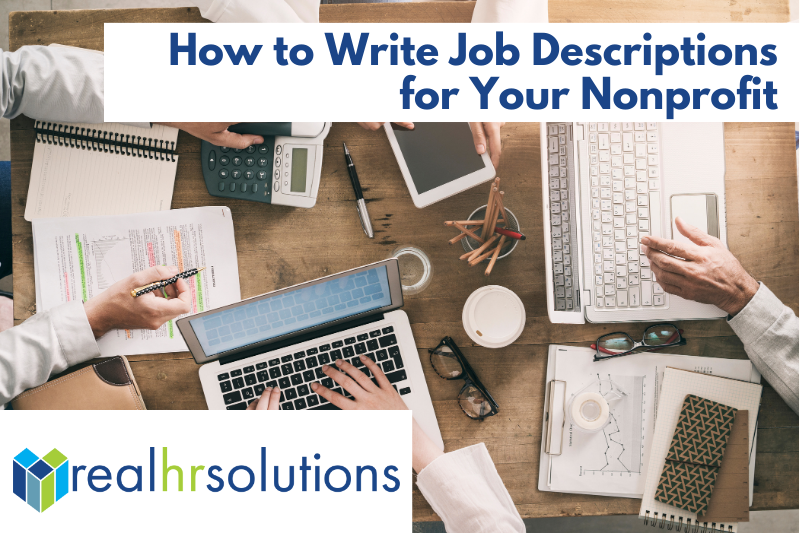 Writing job descriptions is essential to building your nonprofit’s organizational structure and ensuring that employees understand their responsibilities. Job descriptions outline what is expected for employees to do their best work. They also help to clarify where a role fits into the collective organization.
Writing job descriptions is essential to building your nonprofit’s organizational structure and ensuring that employees understand their responsibilities. Job descriptions outline what is expected for employees to do their best work. They also help to clarify where a role fits into the collective organization.
However, it can be challenging to write an adequate job description without experience in the role for which you are creating the description (“JD”), and you might not know where to start. These tips will clarify how to get started:
- Job Description vs. Job Posting: What’s the Difference?
- What is the Purpose of the Role?
- Clearly Identify Roles and Responsibilities
- The Difference Between Skills, Qualifications and Experience
- How Should Soft Skills and Personal Characteristics Be Incorporated?
- Make Adjustments As Needed
Job Description vs. Job Posting: What’s the Difference?
Before you begin to create a job description, it is first important to understand the difference between a job description and a job posting. A job description is an internal document used to define roles and responsibilities for the employee and senior leadership. The job description defines the job, expectations of the role, and where within the organizational structure an employee falls.
A job posting is the external communication about the open vacancy for which a job description was written. A posting is a marketing tool that sells the organization and also describes the role in a broader way.
Well defined templates can provide further clarity between the two.
What is the Purpose of the Role?
Now that you’re ready to begin developing a job description, start with defining the purpose of the role. Why is the role necessary? How does it affect the organization, and what will it contribute?
Defining this early in the process will provide a point of reference for the following steps. What are the objectives of this role? For example, if you were creating a job description for a development associate at your nonprofit, you might have a purpose statement that says:
“The development associate will source and recommend grant applications to the development manager to ensure that the organization is exploring all of the funding resources available. The development associate will also manage donor relations and communications to ensure that the organization is maintaining appropriate levels of transparency with our donors.”
Clearly Identify Duties and Responsibilities
Begin this process of identifying a role’s purpose by:
 Having a conversation with the manager who oversees the position. Discuss responsibilities with the manager and the current employee, if there is one, to be sure that you understand the role.
Having a conversation with the manager who oversees the position. Discuss responsibilities with the manager and the current employee, if there is one, to be sure that you understand the role.
- Prioritizing duties and responsibilities. List the most significant and important duties first. This will ensure that your most essential tasks are understood by the manager, employee, other stakeholders, and future employees.
- Including specifics about the role. Share information about the schedule, position classification (exempt or nonexempt), reporting structure, key departments/roles in engaging with, and any required physical labor, if applicable. Outline what a productive employee looks like.
- Using existing resources. If you are creating a job description for a new role without internal resources to help identify critical characteristics of the position, look into webinars and connect with industry-specific groups. These can help inform the position and the description you are writing.
The Difference Between Required Skills, Qualifications and Experience
Skills are the abilities, techniques, and knowledge a person has acquired over time. These are more specific to the role at hand and might include being skilled in particular software or having precise knowledge about a specific area.
For instance, you might be creating a job description for a fundraising position, and they would need to know the fundraising software your organization is already using. Prioritizing skills in a job description over qualifications and experience may allow a broader pool of talent to be attracted to the position.
Qualifications are areas someone might have been educated in, licenses awarded, or a broad set of experiences that would make them well versed or an expert in a particular subject. It’s here where you would identify whether there is any direct correlation between a specific qualification and the job you are creating. A position might require a license, which would be considered a qualification for the role.
Experience required for a job has traditionally been associated with a person’s time in the field for a particular area of specialty or an industry.
HR professionals have been reporting a unique and notable trend: the shift in what organizations and leaders find necessary for a position.
We have seen less emphasis on experience (years) or qualifications (educational degrees), and more focus on skills. Progressive leaders and hiring managers are beginning to see and understand the vast array of academic and experiential paths. Therefore, they are focusing more on the “end result:” the skill set.
From a diversity, equity, and inclusion perspective, this allows organizations to break down barriers of traditional qualifiers. For example, members of disadvantaged and underserved communities might not always have access to higher educational degrees, but otherwise have the skillset for a particular role. We see an example of this with Google dropping their requirement for a traditional 4-year degree for almost all of their positions.
How Should Soft Skills and Personal Characteristics Be Incorporated?
 Listing the required knowledge, skills, and abilities for a job will help you determine the necessary level of competence for the role. In addition, you want to ensure that the incumbent or candidates personal characteristics are a good fit for your organization. You may consider a
Listing the required knowledge, skills, and abilities for a job will help you determine the necessary level of competence for the role. In addition, you want to ensure that the incumbent or candidates personal characteristics are a good fit for your organization. You may consider a
“nice to have” list. Including it in a job description does a few things:
- It helps understand the role and ensure proper alignment in both hard and soft skills.
- It allows potential employees to understand what personal characteristics align with culture and are the best fit.
For example: “The ideal candidate has experience working in nonprofit fundraising and has demonstrated commitment to social justice in their work or volunteer activities. They are comfortable communicating with people from diverse backgrounds and enjoy working as part of a team.”
Be specific when you describe the desired personal characteristics. For example, “The program director must have excellent communication skills and a proven ability to delegate and motivate others.” If you don’t already have a list of required personal characteristics, ask your team what they think are essential qualities for someone in this role.
Make Adjustments As Needed
After going through this process, it is important to enlist your HR expert to review the JD one final time. An HR professional will make sure the job classification (FLSA) is correct, the status is correct relative to federal and state guidelines, and the salary band is correct. Consider enlisting an HR firm specializing in HR Audits to help review and update job descriptions.
The Bottom Line
The tips above develop a foundation for writing job descriptions for your organization. Job descriptions are a valuable tool for hiring managers and employees. They help employers to hire the right people, and they can also help employees understand their roles better.
Job descriptions are also essential for organizational growth. They help you identify areas where you need additional staff and help determine when current positions are no longer needed, which is essential when considering how best to allocate resources.
If you’re ready to create job descriptions for your nonprofit, start by developing a template, using one from a credible source, or even enlisting help from an HR firm specializing in job description development.
When writing, create an overview of the job and its purpose. Next, identify the required skills, qualifications, and experience needed for each position on your team so you can fill positions with qualified candidates. Finally, include desired personal characteristics such as honesty and integrity and list duties and responsibilities in importance.
About the Author
 Conor Hughes | HR Consultant
Conor Hughes | HR Consultant
Conor is a professionally certified consultant (SHRM-CP), Board Member, and marketer. He enjoys managing projects, creating strategies, and brainstorming ways to bring organizations to new heights. With the company in mind, he strives to serve others by building trust and relationships while guiding them through the process of growth. He seeks to use technology to empower organizations and individuals while guiding all steps of change management.
As a board member of the Westchester Human Resource Management Association, he serves as the Social Media and Marketing Chair. He helps foster collaboration and community engagement for HR professionals across Westchester, NY. Conor specializes in communication and relationship building to strengthen teams. He is passionate about workflow optimization and solution-based technology to enhance an organization’s mission-driven impact.
Outside of his professional engagements, Conor can be found traveling to unique destinations to hike, camp, and explore. He loses track of time when his camera is in his hands, and he has a passion for poetry and painting. While the Hudson Valley will always be his home, he has now found himself exploring the Rocky Mountains in Denver, Colorado.






Leave A Comment